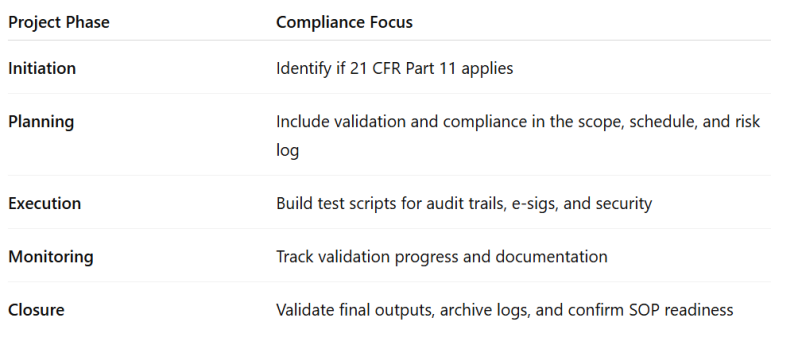As project managers leading IT or digital transformation efforts in regulated industries like biotech, pharma, and medical devices, we’re often tasked with more than just timelines and resource management—we’re responsible for ensuring systems support regulatory compliance from day one. One of the most critical FDA regulations we encounter is 21 CFR Part 11. Whether you're implementing an eQMS, digitizing SOPs, or managing a cloud-based data system, this rule affects how you plan, document, and validate project deliverables.
Here’s what you need to know to stay ahead of compliance requirements—and how to lead your team with confidence.
📘 What Is 21 CFR Part 11?
21 CFR Part 11 is a U.S. FDA regulation that defines the requirements for electronic records and electronic signatures. In simple terms, it ensures that digital records are just as trustworthy, secure, and traceable as paper ones.
If your project includes the use of electronic systems to store, sign, or manage documents used in FDA-regulated processes, you must ensure those systems comply with Part 11.
🧭 Why It Matters for Project Managers
Compliance isn’t just a “check-the-box” exercise—it’s central to system validation, audit readiness, and operational integrity. As a project manager, failing to address Part 11 requirements early can lead to:
- Costly rework
- Failed validation testing
- Delays in go-live or regulatory submissions
- Exposure during FDA audits

🔍 7 Key Compliance Areas PMs Must Understand
- Electronic Records Management
Ensure your solution can:
- Maintain data integrity over time
- Restrict unauthorized changes
- Provide complete version control
- Electronic Signatures
Does your system:
- Uniquely identify each signer?
- Time-stamp every action?
- Prevent signature duplication or tampering?
- Audit Trails
Your system must:
- Track all changes (who, what, when, why)
- Maintain logs in a secure and reviewable format
- System Validation
Work with QA and IT to:
- Create a validation plan (IQ/OQ/PQ)
- Test every feature that impacts data capture or compliance
- Document everything—from requirements to test results
- Security & Access Control
Ensure:
- Role-based access is enforced
- Multifactor authentication is enabled (when possible)
- User privileges align with SOPs and regulatory expectations
- Training & SOPs
Project deliverables must include:
- Updated SOPs for system usage
- Role-specific training materials
- Change management documentation
- Vendor Qualification
If using a third-party platform (like TrackWise Digital, MasterControl, or Veeva Vault), ensure:
- Vendor has a compliance roadmap
- You have their validation package or SOC reports
- Vendor agreements reflect shared compliance responsibilities
📅 When to Address Part 11 in Your Project Plan
Don't wait until UAT. Here’s where you should bake in compliance checkpoints:

⚙️ Tools That Support Part 11 Projects
As a PM, your toolkit should include platforms that simplify validation and compliance:
- TrackWise Digital – EQMS with validation-ready modules
- MasterControl – Document control and training management
- ValGenesis – Validation lifecycle management
- SharePoint with Custom Workflows – When configured properly, it can support controlled document management
🧠 Final Thoughts: Leading with Compliance Confidence
21 CFR Part 11 compliance doesn’t have to be intimidating—it just needs to be planned for. As project managers, we play a crucial role in ensuring our teams build, test, and document systems that can stand up to regulatory scrutiny.
💬 Ask the right questions.
🗂 Involve the right stakeholders early.
🛡 Treat compliance as a requirement, not a risk.
Remember: FDA compliance isn’t just about passing audits—it’s about protecting patients, data, and your organization’s integrity.
#21CFRPart11 #ProjectManagement #FDACompliance #LifeSciencesIT #DigitalValidation #eQMS #AgileInRegulatedIndustries #ManagingProjectsTheAgileWay #RiskManagement #SystemValidation #ManagingProjectsTheAgileWay
Download Document, PDF, or Presentation
Author: Kimberly Wiethoff